MANM4000 Report: Addressing Misconceptions about Employee Motivation
VerifiedAdded on 2023/03/30
|7
|1465
|86
Report
AI Summary
This report addresses prevalent misconceptions regarding employee motivation in organizations, drawing upon established theories and models. It challenges the notion that rewards are the sole motivator, highlighting potential complacency. The report also critiques the misconception of autonomy, where employee task selection may not align with organizational goals. Furthermore, it discusses the fallacy that motivation always satisfies employee needs, the disconnect between happiness and motivation, and the limitations of concrete motivational actions. The report also considers the misconception that increased pay or altered working conditions guarantee sustained motivation, and that all tasks can be inherently motivating. Finally, it argues against the idea that money is the primary motivator and shares an opinion on older worker's efficiency. This report provides a comprehensive analysis of these misconceptions, supported by research and practical insights.
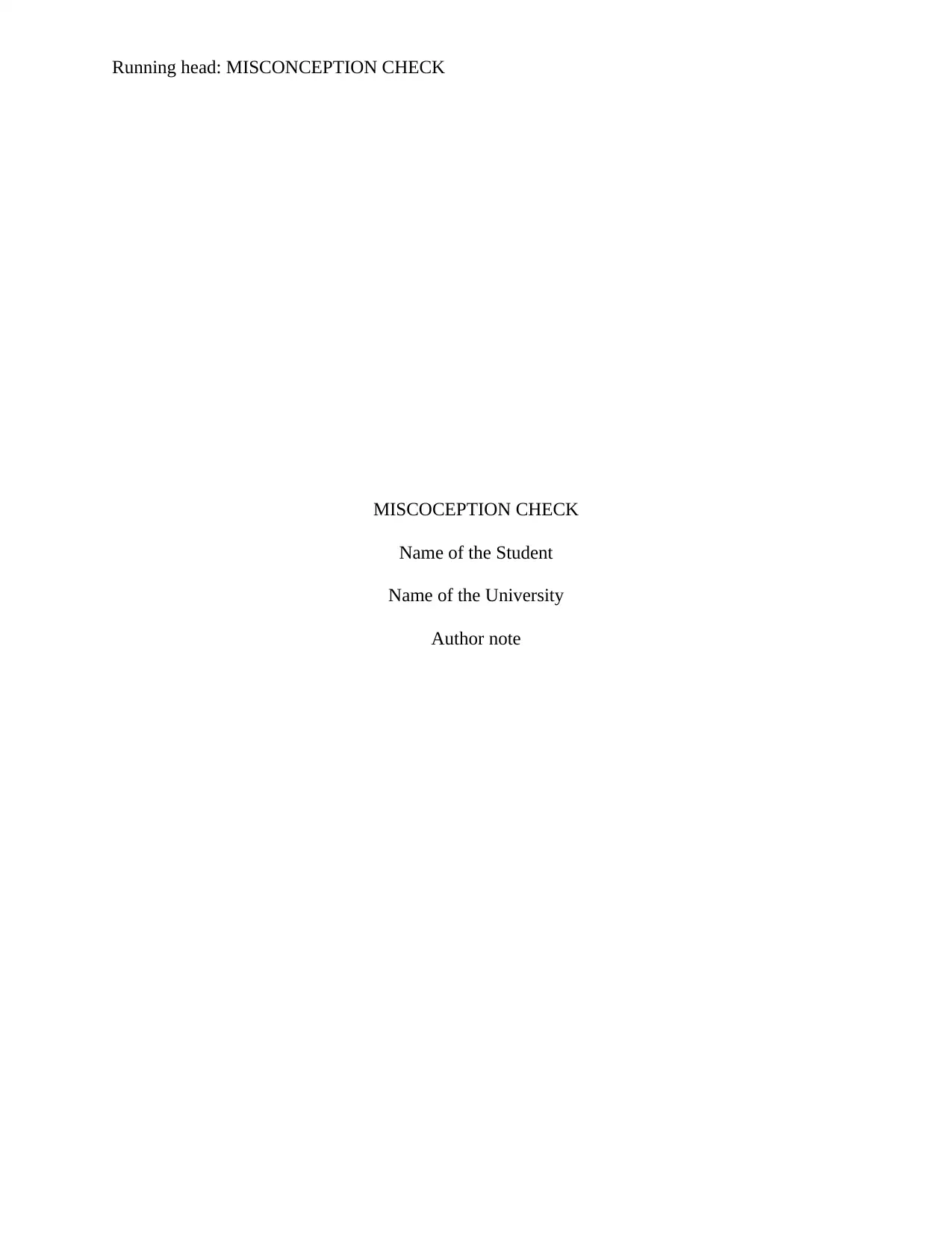
Running head: MISCONCEPTION CHECK
MISCOCEPTION CHECK
Name of the Student
Name of the University
Author note
MISCOCEPTION CHECK
Name of the Student
Name of the University
Author note
Paraphrase This Document
Need a fresh take? Get an instant paraphrase of this document with our AI Paraphraser
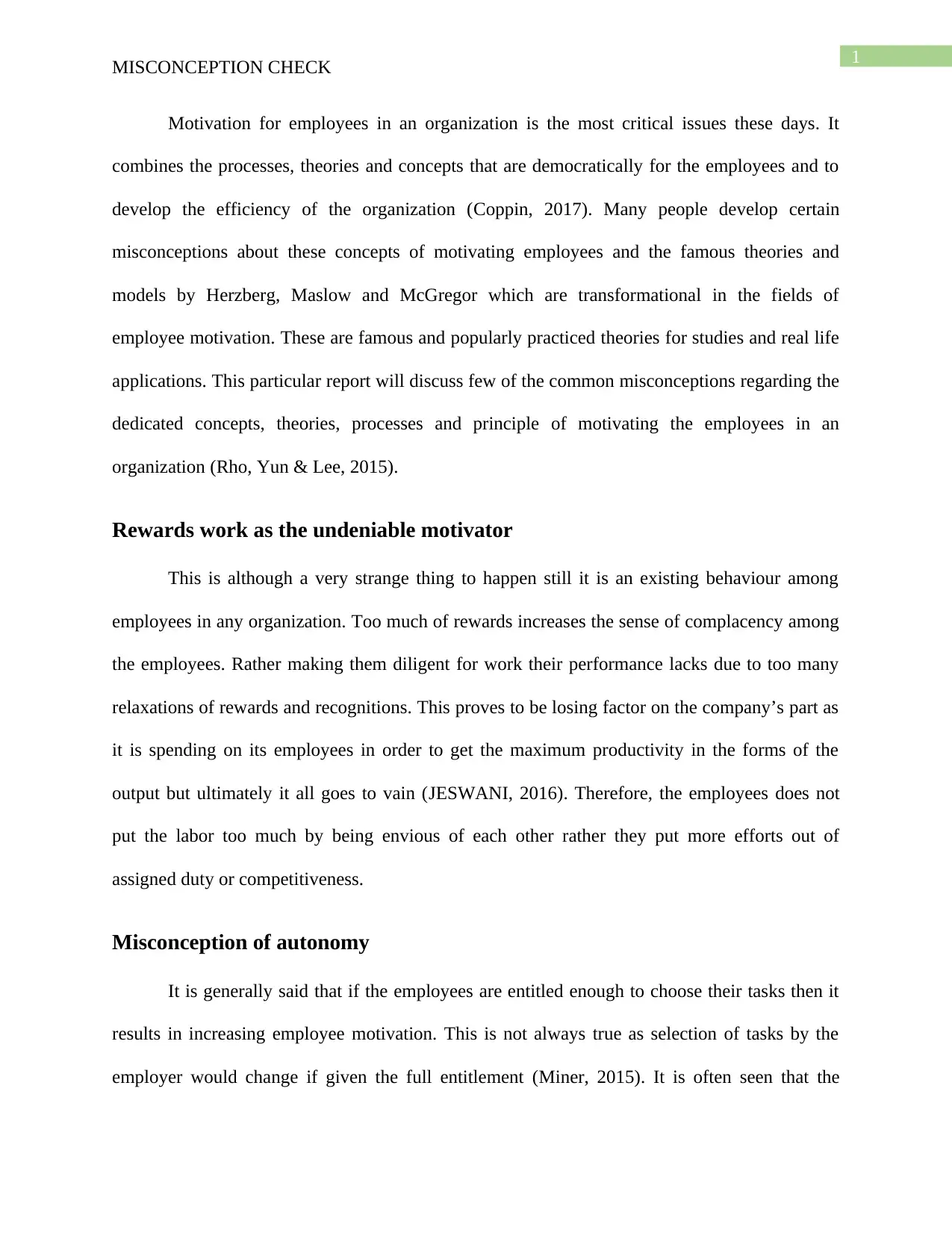
1
MISCONCEPTION CHECK
Motivation for employees in an organization is the most critical issues these days. It
combines the processes, theories and concepts that are democratically for the employees and to
develop the efficiency of the organization (Coppin, 2017). Many people develop certain
misconceptions about these concepts of motivating employees and the famous theories and
models by Herzberg, Maslow and McGregor which are transformational in the fields of
employee motivation. These are famous and popularly practiced theories for studies and real life
applications. This particular report will discuss few of the common misconceptions regarding the
dedicated concepts, theories, processes and principle of motivating the employees in an
organization (Rho, Yun & Lee, 2015).
Rewards work as the undeniable motivator
This is although a very strange thing to happen still it is an existing behaviour among
employees in any organization. Too much of rewards increases the sense of complacency among
the employees. Rather making them diligent for work their performance lacks due to too many
relaxations of rewards and recognitions. This proves to be losing factor on the company’s part as
it is spending on its employees in order to get the maximum productivity in the forms of the
output but ultimately it all goes to vain (JESWANI, 2016). Therefore, the employees does not
put the labor too much by being envious of each other rather they put more efforts out of
assigned duty or competitiveness.
Misconception of autonomy
It is generally said that if the employees are entitled enough to choose their tasks then it
results in increasing employee motivation. This is not always true as selection of tasks by the
employer would change if given the full entitlement (Miner, 2015). It is often seen that the
MISCONCEPTION CHECK
Motivation for employees in an organization is the most critical issues these days. It
combines the processes, theories and concepts that are democratically for the employees and to
develop the efficiency of the organization (Coppin, 2017). Many people develop certain
misconceptions about these concepts of motivating employees and the famous theories and
models by Herzberg, Maslow and McGregor which are transformational in the fields of
employee motivation. These are famous and popularly practiced theories for studies and real life
applications. This particular report will discuss few of the common misconceptions regarding the
dedicated concepts, theories, processes and principle of motivating the employees in an
organization (Rho, Yun & Lee, 2015).
Rewards work as the undeniable motivator
This is although a very strange thing to happen still it is an existing behaviour among
employees in any organization. Too much of rewards increases the sense of complacency among
the employees. Rather making them diligent for work their performance lacks due to too many
relaxations of rewards and recognitions. This proves to be losing factor on the company’s part as
it is spending on its employees in order to get the maximum productivity in the forms of the
output but ultimately it all goes to vain (JESWANI, 2016). Therefore, the employees does not
put the labor too much by being envious of each other rather they put more efforts out of
assigned duty or competitiveness.
Misconception of autonomy
It is generally said that if the employees are entitled enough to choose their tasks then it
results in increasing employee motivation. This is not always true as selection of tasks by the
employer would change if given the full entitlement (Miner, 2015). It is often seen that the
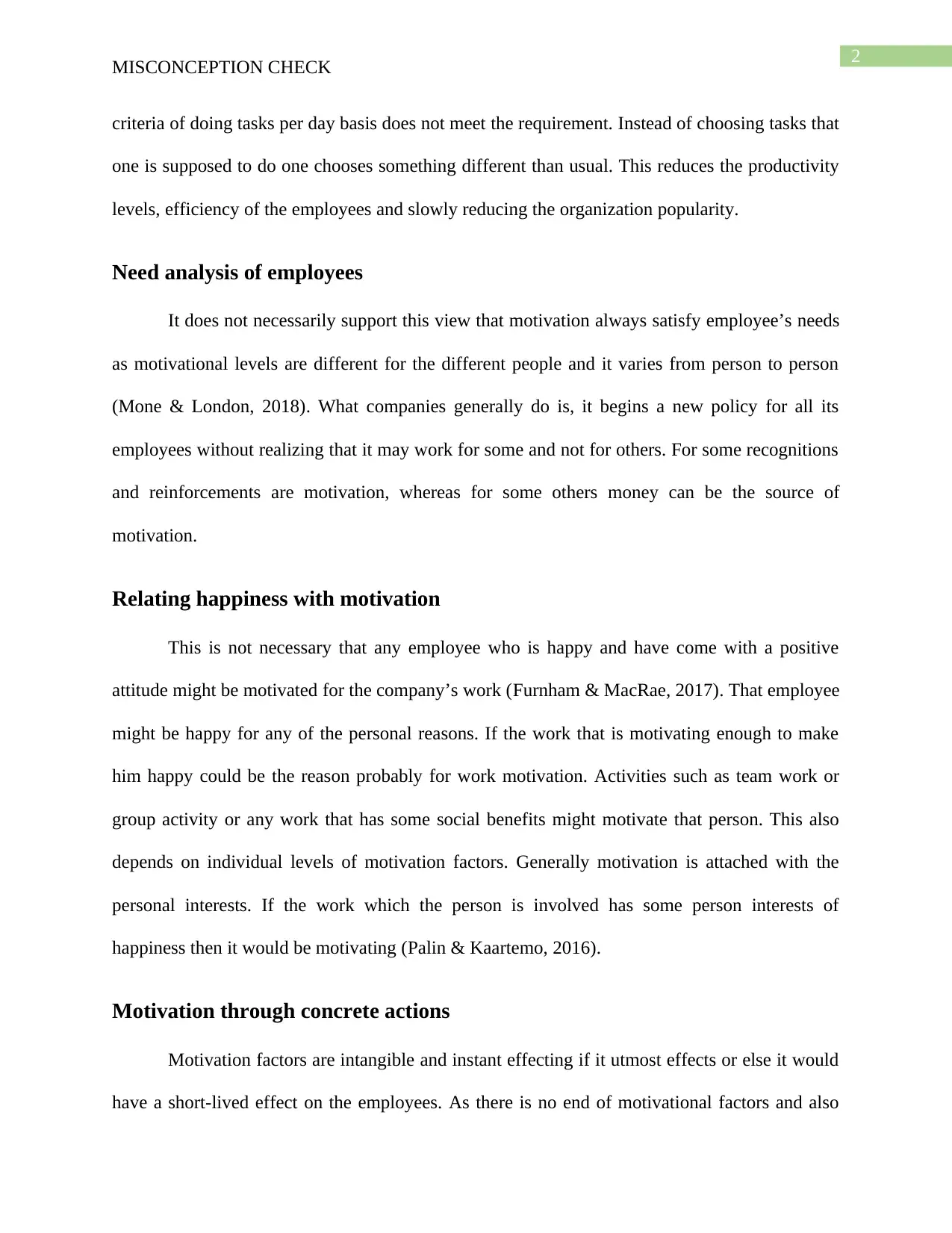
2
MISCONCEPTION CHECK
criteria of doing tasks per day basis does not meet the requirement. Instead of choosing tasks that
one is supposed to do one chooses something different than usual. This reduces the productivity
levels, efficiency of the employees and slowly reducing the organization popularity.
Need analysis of employees
It does not necessarily support this view that motivation always satisfy employee’s needs
as motivational levels are different for the different people and it varies from person to person
(Mone & London, 2018). What companies generally do is, it begins a new policy for all its
employees without realizing that it may work for some and not for others. For some recognitions
and reinforcements are motivation, whereas for some others money can be the source of
motivation.
Relating happiness with motivation
This is not necessary that any employee who is happy and have come with a positive
attitude might be motivated for the company’s work (Furnham & MacRae, 2017). That employee
might be happy for any of the personal reasons. If the work that is motivating enough to make
him happy could be the reason probably for work motivation. Activities such as team work or
group activity or any work that has some social benefits might motivate that person. This also
depends on individual levels of motivation factors. Generally motivation is attached with the
personal interests. If the work which the person is involved has some person interests of
happiness then it would be motivating (Palin & Kaartemo, 2016).
Motivation through concrete actions
Motivation factors are intangible and instant effecting if it utmost effects or else it would
have a short-lived effect on the employees. As there is no end of motivational factors and also
MISCONCEPTION CHECK
criteria of doing tasks per day basis does not meet the requirement. Instead of choosing tasks that
one is supposed to do one chooses something different than usual. This reduces the productivity
levels, efficiency of the employees and slowly reducing the organization popularity.
Need analysis of employees
It does not necessarily support this view that motivation always satisfy employee’s needs
as motivational levels are different for the different people and it varies from person to person
(Mone & London, 2018). What companies generally do is, it begins a new policy for all its
employees without realizing that it may work for some and not for others. For some recognitions
and reinforcements are motivation, whereas for some others money can be the source of
motivation.
Relating happiness with motivation
This is not necessary that any employee who is happy and have come with a positive
attitude might be motivated for the company’s work (Furnham & MacRae, 2017). That employee
might be happy for any of the personal reasons. If the work that is motivating enough to make
him happy could be the reason probably for work motivation. Activities such as team work or
group activity or any work that has some social benefits might motivate that person. This also
depends on individual levels of motivation factors. Generally motivation is attached with the
personal interests. If the work which the person is involved has some person interests of
happiness then it would be motivating (Palin & Kaartemo, 2016).
Motivation through concrete actions
Motivation factors are intangible and instant effecting if it utmost effects or else it would
have a short-lived effect on the employees. As there is no end of motivational factors and also
⊘ This is a preview!⊘
Do you want full access?
Subscribe today to unlock all pages.

Trusted by 1+ million students worldwide
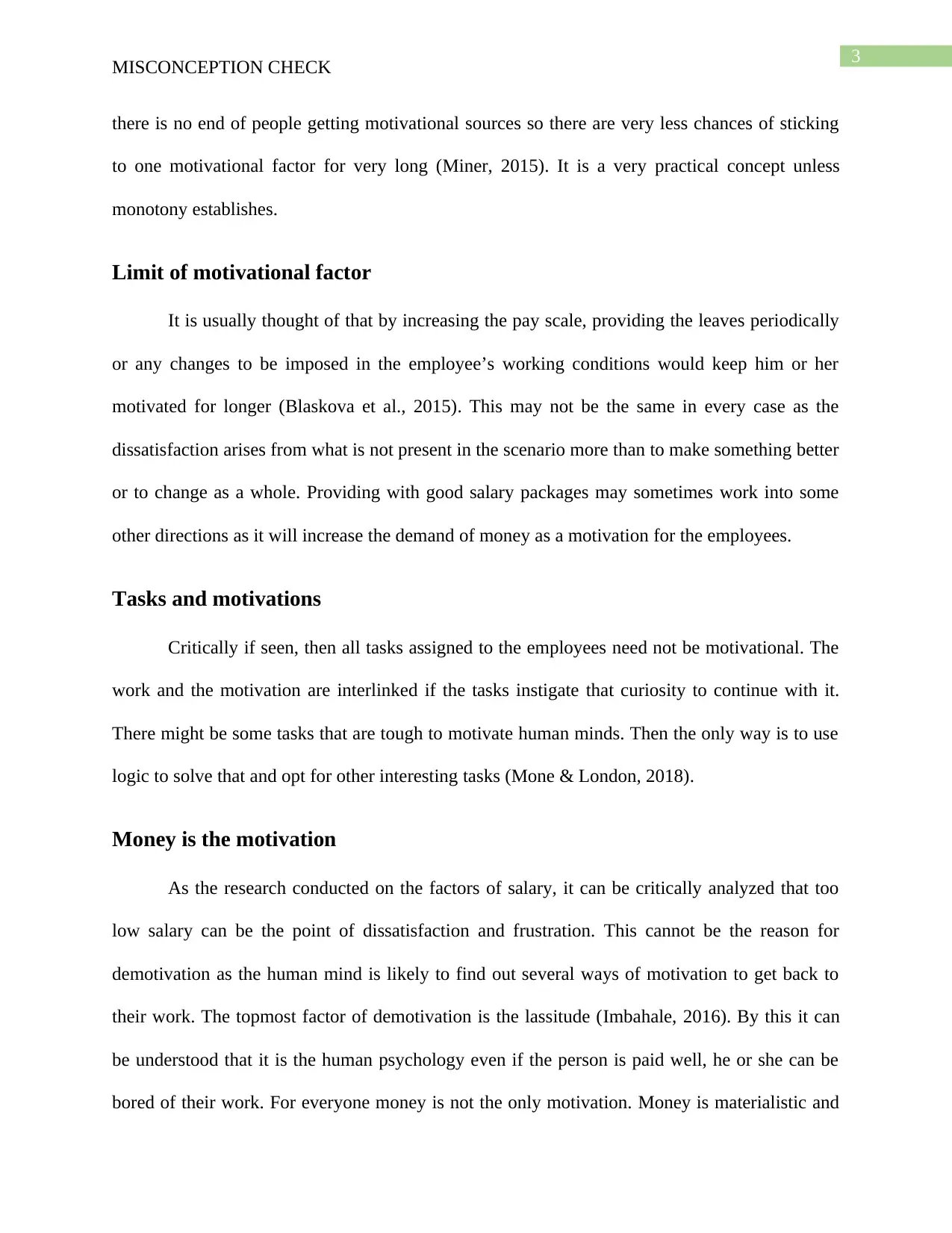
3
MISCONCEPTION CHECK
there is no end of people getting motivational sources so there are very less chances of sticking
to one motivational factor for very long (Miner, 2015). It is a very practical concept unless
monotony establishes.
Limit of motivational factor
It is usually thought of that by increasing the pay scale, providing the leaves periodically
or any changes to be imposed in the employee’s working conditions would keep him or her
motivated for longer (Blaskova et al., 2015). This may not be the same in every case as the
dissatisfaction arises from what is not present in the scenario more than to make something better
or to change as a whole. Providing with good salary packages may sometimes work into some
other directions as it will increase the demand of money as a motivation for the employees.
Tasks and motivations
Critically if seen, then all tasks assigned to the employees need not be motivational. The
work and the motivation are interlinked if the tasks instigate that curiosity to continue with it.
There might be some tasks that are tough to motivate human minds. Then the only way is to use
logic to solve that and opt for other interesting tasks (Mone & London, 2018).
Money is the motivation
As the research conducted on the factors of salary, it can be critically analyzed that too
low salary can be the point of dissatisfaction and frustration. This cannot be the reason for
demotivation as the human mind is likely to find out several ways of motivation to get back to
their work. The topmost factor of demotivation is the lassitude (Imbahale, 2016). By this it can
be understood that it is the human psychology even if the person is paid well, he or she can be
bored of their work. For everyone money is not the only motivation. Money is materialistic and
MISCONCEPTION CHECK
there is no end of people getting motivational sources so there are very less chances of sticking
to one motivational factor for very long (Miner, 2015). It is a very practical concept unless
monotony establishes.
Limit of motivational factor
It is usually thought of that by increasing the pay scale, providing the leaves periodically
or any changes to be imposed in the employee’s working conditions would keep him or her
motivated for longer (Blaskova et al., 2015). This may not be the same in every case as the
dissatisfaction arises from what is not present in the scenario more than to make something better
or to change as a whole. Providing with good salary packages may sometimes work into some
other directions as it will increase the demand of money as a motivation for the employees.
Tasks and motivations
Critically if seen, then all tasks assigned to the employees need not be motivational. The
work and the motivation are interlinked if the tasks instigate that curiosity to continue with it.
There might be some tasks that are tough to motivate human minds. Then the only way is to use
logic to solve that and opt for other interesting tasks (Mone & London, 2018).
Money is the motivation
As the research conducted on the factors of salary, it can be critically analyzed that too
low salary can be the point of dissatisfaction and frustration. This cannot be the reason for
demotivation as the human mind is likely to find out several ways of motivation to get back to
their work. The topmost factor of demotivation is the lassitude (Imbahale, 2016). By this it can
be understood that it is the human psychology even if the person is paid well, he or she can be
bored of their work. For everyone money is not the only motivation. Money is materialistic and
Paraphrase This Document
Need a fresh take? Get an instant paraphrase of this document with our AI Paraphraser
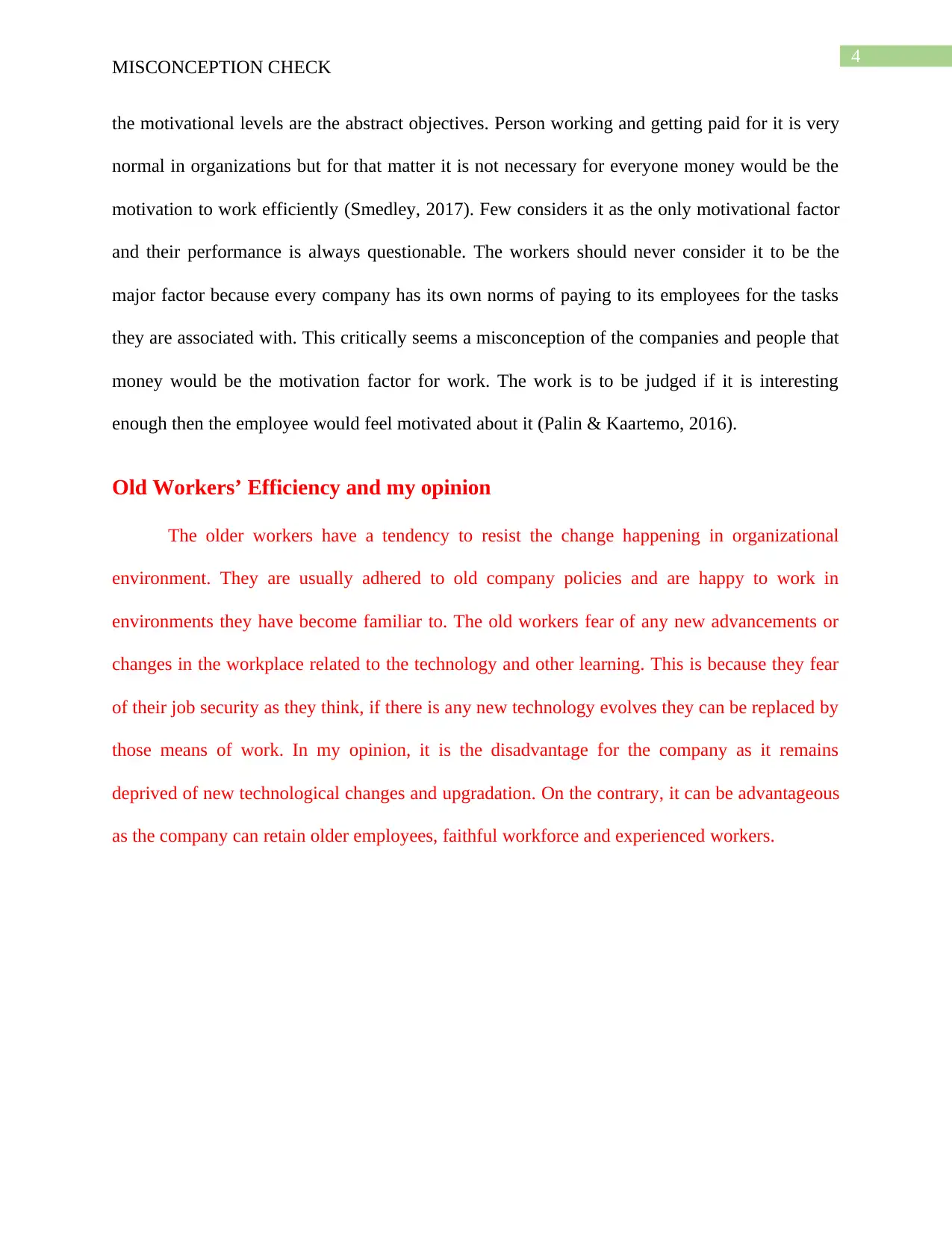
4
MISCONCEPTION CHECK
the motivational levels are the abstract objectives. Person working and getting paid for it is very
normal in organizations but for that matter it is not necessary for everyone money would be the
motivation to work efficiently (Smedley, 2017). Few considers it as the only motivational factor
and their performance is always questionable. The workers should never consider it to be the
major factor because every company has its own norms of paying to its employees for the tasks
they are associated with. This critically seems a misconception of the companies and people that
money would be the motivation factor for work. The work is to be judged if it is interesting
enough then the employee would feel motivated about it (Palin & Kaartemo, 2016).
Old Workers’ Efficiency and my opinion
The older workers have a tendency to resist the change happening in organizational
environment. They are usually adhered to old company policies and are happy to work in
environments they have become familiar to. The old workers fear of any new advancements or
changes in the workplace related to the technology and other learning. This is because they fear
of their job security as they think, if there is any new technology evolves they can be replaced by
those means of work. In my opinion, it is the disadvantage for the company as it remains
deprived of new technological changes and upgradation. On the contrary, it can be advantageous
as the company can retain older employees, faithful workforce and experienced workers.
MISCONCEPTION CHECK
the motivational levels are the abstract objectives. Person working and getting paid for it is very
normal in organizations but for that matter it is not necessary for everyone money would be the
motivation to work efficiently (Smedley, 2017). Few considers it as the only motivational factor
and their performance is always questionable. The workers should never consider it to be the
major factor because every company has its own norms of paying to its employees for the tasks
they are associated with. This critically seems a misconception of the companies and people that
money would be the motivation factor for work. The work is to be judged if it is interesting
enough then the employee would feel motivated about it (Palin & Kaartemo, 2016).
Old Workers’ Efficiency and my opinion
The older workers have a tendency to resist the change happening in organizational
environment. They are usually adhered to old company policies and are happy to work in
environments they have become familiar to. The old workers fear of any new advancements or
changes in the workplace related to the technology and other learning. This is because they fear
of their job security as they think, if there is any new technology evolves they can be replaced by
those means of work. In my opinion, it is the disadvantage for the company as it remains
deprived of new technological changes and upgradation. On the contrary, it can be advantageous
as the company can retain older employees, faithful workforce and experienced workers.
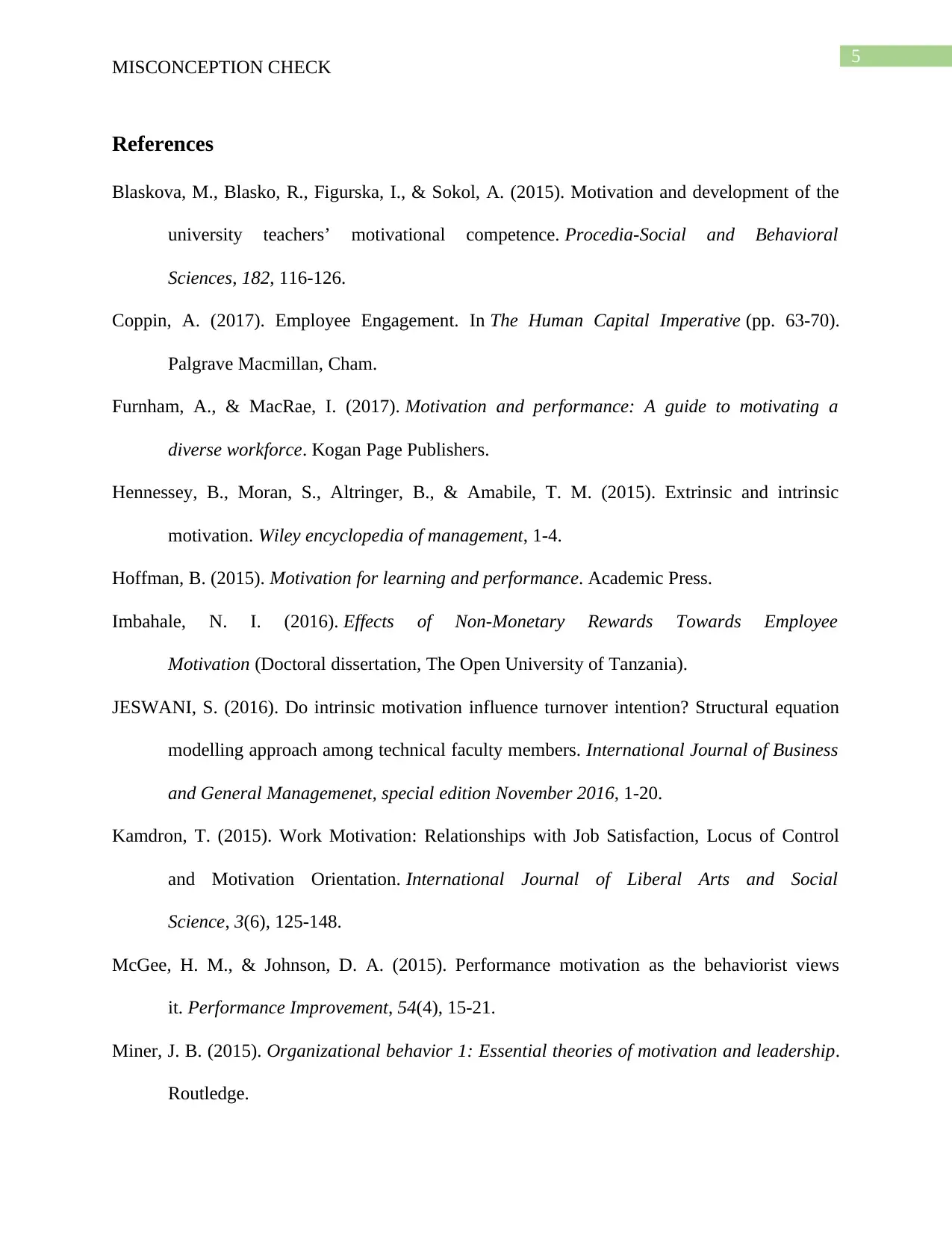
5
MISCONCEPTION CHECK
References
Blaskova, M., Blasko, R., Figurska, I., & Sokol, A. (2015). Motivation and development of the
university teachers’ motivational competence. Procedia-Social and Behavioral
Sciences, 182, 116-126.
Coppin, A. (2017). Employee Engagement. In The Human Capital Imperative (pp. 63-70).
Palgrave Macmillan, Cham.
Furnham, A., & MacRae, I. (2017). Motivation and performance: A guide to motivating a
diverse workforce. Kogan Page Publishers.
Hennessey, B., Moran, S., Altringer, B., & Amabile, T. M. (2015). Extrinsic and intrinsic
motivation. Wiley encyclopedia of management, 1-4.
Hoffman, B. (2015). Motivation for learning and performance. Academic Press.
Imbahale, N. I. (2016). Effects of Non-Monetary Rewards Towards Employee
Motivation (Doctoral dissertation, The Open University of Tanzania).
JESWANI, S. (2016). Do intrinsic motivation influence turnover intention? Structural equation
modelling approach among technical faculty members. International Journal of Business
and General Managemenet, special edition November 2016, 1-20.
Kamdron, T. (2015). Work Motivation: Relationships with Job Satisfaction, Locus of Control
and Motivation Orientation. International Journal of Liberal Arts and Social
Science, 3(6), 125-148.
McGee, H. M., & Johnson, D. A. (2015). Performance motivation as the behaviorist views
it. Performance Improvement, 54(4), 15-21.
Miner, J. B. (2015). Organizational behavior 1: Essential theories of motivation and leadership.
Routledge.
MISCONCEPTION CHECK
References
Blaskova, M., Blasko, R., Figurska, I., & Sokol, A. (2015). Motivation and development of the
university teachers’ motivational competence. Procedia-Social and Behavioral
Sciences, 182, 116-126.
Coppin, A. (2017). Employee Engagement. In The Human Capital Imperative (pp. 63-70).
Palgrave Macmillan, Cham.
Furnham, A., & MacRae, I. (2017). Motivation and performance: A guide to motivating a
diverse workforce. Kogan Page Publishers.
Hennessey, B., Moran, S., Altringer, B., & Amabile, T. M. (2015). Extrinsic and intrinsic
motivation. Wiley encyclopedia of management, 1-4.
Hoffman, B. (2015). Motivation for learning and performance. Academic Press.
Imbahale, N. I. (2016). Effects of Non-Monetary Rewards Towards Employee
Motivation (Doctoral dissertation, The Open University of Tanzania).
JESWANI, S. (2016). Do intrinsic motivation influence turnover intention? Structural equation
modelling approach among technical faculty members. International Journal of Business
and General Managemenet, special edition November 2016, 1-20.
Kamdron, T. (2015). Work Motivation: Relationships with Job Satisfaction, Locus of Control
and Motivation Orientation. International Journal of Liberal Arts and Social
Science, 3(6), 125-148.
McGee, H. M., & Johnson, D. A. (2015). Performance motivation as the behaviorist views
it. Performance Improvement, 54(4), 15-21.
Miner, J. B. (2015). Organizational behavior 1: Essential theories of motivation and leadership.
Routledge.
⊘ This is a preview!⊘
Do you want full access?
Subscribe today to unlock all pages.

Trusted by 1+ million students worldwide
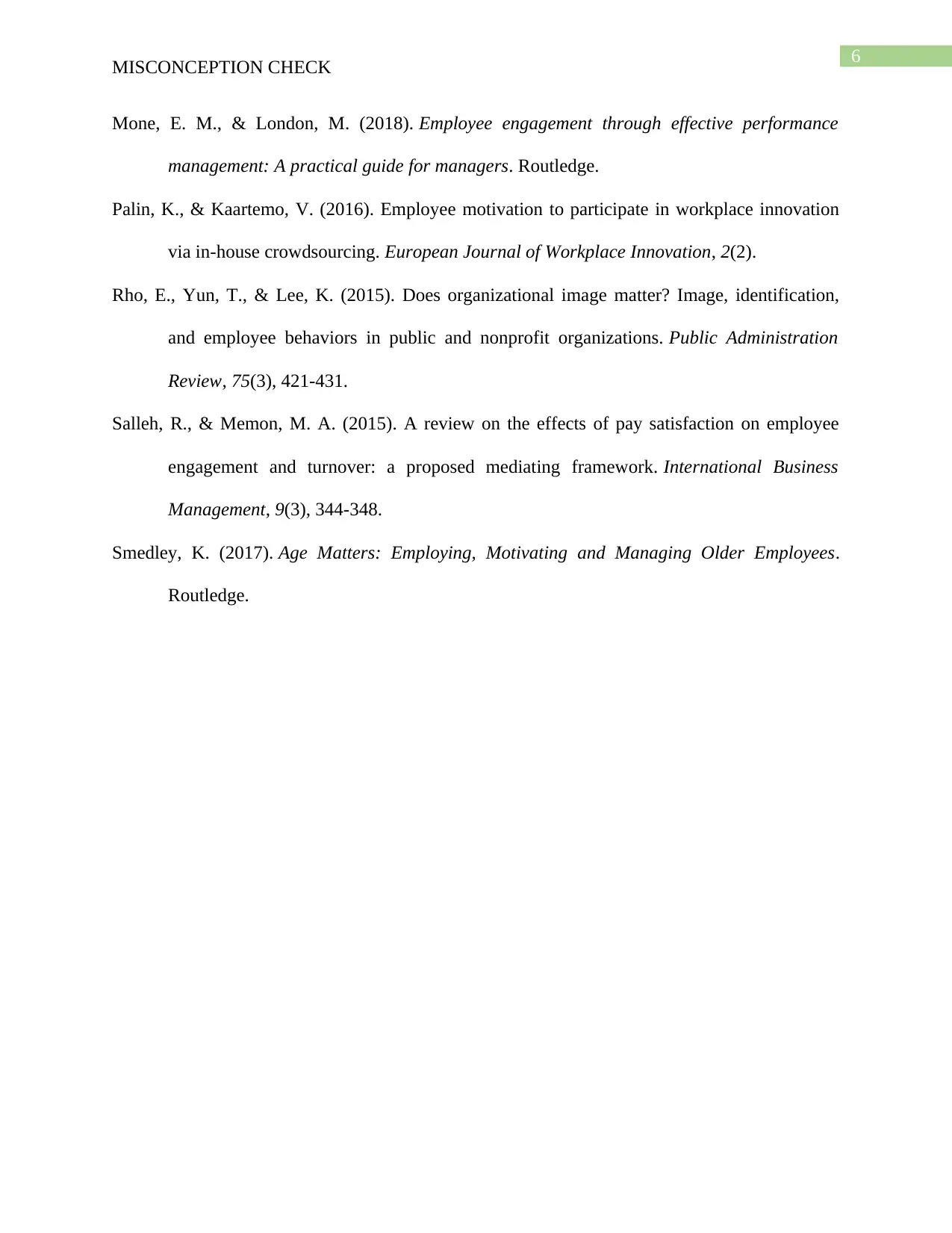
6
MISCONCEPTION CHECK
Mone, E. M., & London, M. (2018). Employee engagement through effective performance
management: A practical guide for managers. Routledge.
Palin, K., & Kaartemo, V. (2016). Employee motivation to participate in workplace innovation
via in-house crowdsourcing. European Journal of Workplace Innovation, 2(2).
Rho, E., Yun, T., & Lee, K. (2015). Does organizational image matter? Image, identification,
and employee behaviors in public and nonprofit organizations. Public Administration
Review, 75(3), 421-431.
Salleh, R., & Memon, M. A. (2015). A review on the effects of pay satisfaction on employee
engagement and turnover: a proposed mediating framework. International Business
Management, 9(3), 344-348.
Smedley, K. (2017). Age Matters: Employing, Motivating and Managing Older Employees.
Routledge.
MISCONCEPTION CHECK
Mone, E. M., & London, M. (2018). Employee engagement through effective performance
management: A practical guide for managers. Routledge.
Palin, K., & Kaartemo, V. (2016). Employee motivation to participate in workplace innovation
via in-house crowdsourcing. European Journal of Workplace Innovation, 2(2).
Rho, E., Yun, T., & Lee, K. (2015). Does organizational image matter? Image, identification,
and employee behaviors in public and nonprofit organizations. Public Administration
Review, 75(3), 421-431.
Salleh, R., & Memon, M. A. (2015). A review on the effects of pay satisfaction on employee
engagement and turnover: a proposed mediating framework. International Business
Management, 9(3), 344-348.
Smedley, K. (2017). Age Matters: Employing, Motivating and Managing Older Employees.
Routledge.
1 out of 7
Related Documents
Your All-in-One AI-Powered Toolkit for Academic Success.
+13062052269
info@desklib.com
Available 24*7 on WhatsApp / Email
![[object Object]](/_next/static/media/star-bottom.7253800d.svg)
Unlock your academic potential
Copyright © 2020–2025 A2Z Services. All Rights Reserved. Developed and managed by ZUCOL.




